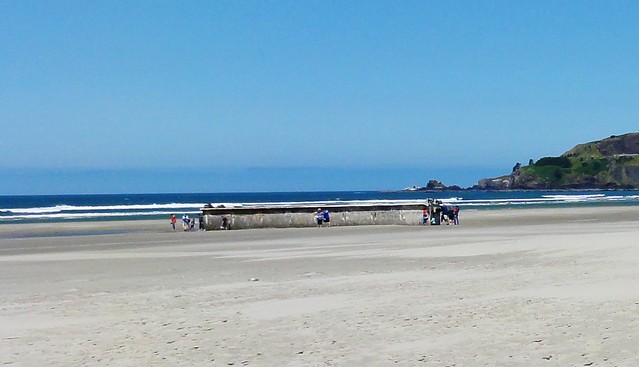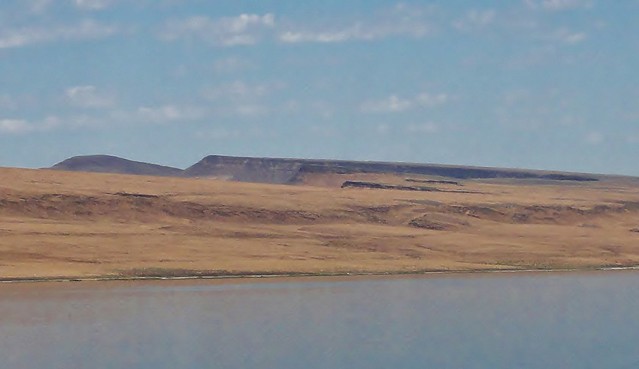This article was published in Scientific American’s former blog network and reflects the views of the author, not necessarily those of Scientific American
When you live in an area at as much geologic risk as Oregon, you would expect that government officials would maybe, possibly, take those risks seriously. But the people who currently govern Oregon seem quite determined to ignore hazards and let the state languish unprepared.
It's bad enough that legislators voted this month to allow "new schools, hospitals, jails, and police and fire stations" to be built in areas that will most certainly be inundated in the event of a tsunami. Both parties think it's a good idea now; I doubt they'll still be feeling great about locating schools right in the path of rampaging seawater when the big one hits. But short-term economic gain outweighs long-term planning, so here we are. What else can we expect from a statehouse where lawmakers who would rather flee the state than be forced to deal with climate change?
People say they're willing to accept the risks. However, the state government is now planning to make it far harder for residents to even know what those risks are, because Oregon's Department of Geology and Mineral Industries (DOGAMI for short) is severely underfunded and will now lose three critically-needed experts on staff as a punishment for going over budget. As if that weren't bad enough, the governor's office is considering whether the agency should even continue to exist:
On supporting science journalism
If you're enjoying this article, consider supporting our award-winning journalism by subscribing. By purchasing a subscription you are helping to ensure the future of impactful stories about the discoveries and ideas shaping our world today.
In a note on the preliminary budget proposal for the agency, the Joint Ways and Means Committee said the Governor’s office would be “evaluating if the Department should continue to exist as an independent or recommendations to abolish and move the individual programs to other entities.”
That drastic of a move could come with big consequences, Avy said.
“It would be incredibly disruptive to staff and it is likely that some on-going studies would be discontinued,” he said.”Oregon would lose a valued agency and may lose talented staff in our Geological Survey and Services Program which provides a focus on geologic and mineral mapping and natural hazard identification.”
Can we be real for a minute, here? Oregon is a geologically young state in an active subduction zone, located on an ocean that has subduction zones on both sides, which generate ocean-spanning tsunamis on a regular basis. The local subduction zone, plus Basin and Range crustal stretching and faulting, also produces active volcanoes. Many, many volcanoes. Also, too, all of this folding and faulting and uplifting and volcanoing leaves the state terribly landslide prone. This is not a place where you can safely starve your local geological survey of funds, and then shut it down when it needs extra money to identify and quantify the hazards you face.
So if you live in Oregon, or even if you just visit, I'd strongly consider writing a polite but serious missive to Governor Kate Brown, letting her know that it would perhaps be a good idea to look further into the possible repercussions of signing that deplorable tsunami bill (I mean, at least take the schools out of the mix!), and also fully fund DOGAMI rather than further crippling it and then stripping it for parts.
Let's have a brief tour of Oregon's geohazards which DOGAMI helps protect us from, then, shall we?
The Oregon coast is extremely susceptible to tsunamis, both generated from Cascadia and from other subduction zones along the Pacific Ocean. You can see evidence of them everywhere.
One of the starkest reminders in recent times was the dock that was ripped from the shoreline in Misawa, Japan, in the brutal 2011 Tōhoku Earthquake. The tsunami that sheared it loose and set it afloat also washed ashore in California and Oregon, causing millions of dollars in damage; loss of life in the United States was only avoided due to ample warnings. Just over a year later, the dock washed up on Agate Beach.

The dock at Agate Beach, prior to its removal. Credit: Dana Hunter
A close inspection of the massive dock shows the power of earthquakes and tsunamis to destroy what we have made.

Imagine the force it took to create this kind of damage. Credit: Dana Hunter
At Agate Beach, homes and businesses are built right in the path of the next Cascadia tsunami. I can't describe to you the eerie sensation you feel turning away from that dock to see vulnerable structures that will be piles of flooded rubble after the next tsunami hits.

Residences and businesses on Agate Beach. Even a modest tsunami will cause untold damage to these structures. Credit: Dana Hunter
The people here will have minutes to find high ground after the shaking stops, if that long. There is some high ground nearby, but not much, and perhaps not near enough. Roads will probably be destroyed or blocked in the quake. This is the sort of location the legislature has decided it would be fine to site schools.
Going hand-in-hand with tsunamis are earthquakes.

The stump of a drowned spruce at Sunset Bay, Shore Acres, OR. Lockwood DeWitt for scale. Credit: Dana Hunter
Sunset Bay is the site of one of Oregon's many ghost forests. Here, a Cascadia earthquake dropped the shoreline about 1,200 years ago, suddenly drowning huge, healthy trees in salt water. At least seven spectacular earthquakes have hit the Oregon coast in the past 3,500 years. It may not sound like much, or often... but look to Japan for the reason why we should take the threat extremely seriously. And Oregon doesn't just have to worry about Cascadia quakes: the state is full of faults, stretching from north to south and from coast to interior.

A view of Basin and Range fault block mountains across Lake Abert. Credit: Dana Hunter
Huge swathes of Oregon are volcanic. As in, recently volcanic. As in, will definitely erupt again quite soon.
Mount Hood, a sibling to Mount St. Helens, is right outside of Portland and last erupted in the mid-1800s. It is hazardous as heck.

The summit of Mount Hood. See how raw it is? Credit: Dana Hunter
But Hood is very, very far from the only young volcano in the state, and evidence of recent eruptions is everywhere. Belknap shield volcano and its associated volcanoes on McKenzie Pass ceased erupting only 1,500 years ago, and the forces that created it are still active today. Another volcanic center like it could emerge in the near future. And you see here just a tiny swath of the destruction such a volcanic center causes.

Lava flows near Dee Wright Volcano Observatory. Credit: Dana Hunter
You know what you really don't want to be caught unawares by? A volcano. And even once they've stopped erupting, the buggers can be dangerous. Sector collapses, lahars, and other woes plague old volcanoes. You need people who can keep a sharp eye on them. And I'm sorry, but the USGS can't be everywhere at once. Local volcano monitoring is important!
If you're an Oregon resident, you'll probably remember how bloody long it took to finish the Eddyville Bypass due to the massive landslide that got reactivated during construction. Steep terrain plus plenty of rain equals lots of rock and soil going where we'd prefer it didn't.
Debris flows and landslides regularly take out Oregon roads, including this stretch on a drainage by Mount Hood.

Construction equipment copes with damage caused by massive debris flows coming down from Mount Hood. Credit: Dana Hunter
We know from the Oso mudslide just how deadly these mass movements can be. Having experts out there who understand how to map the geology of an area and identify problem areas is critically important, especially in places where a lot of people want to live, work, and play.
Contact the governor's office and let her know if you don't think it's worth letting a budget shortfall torpedo the agency that should be doing the most to identify these hazards and help us mitigate them.